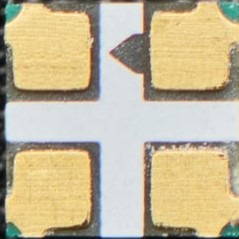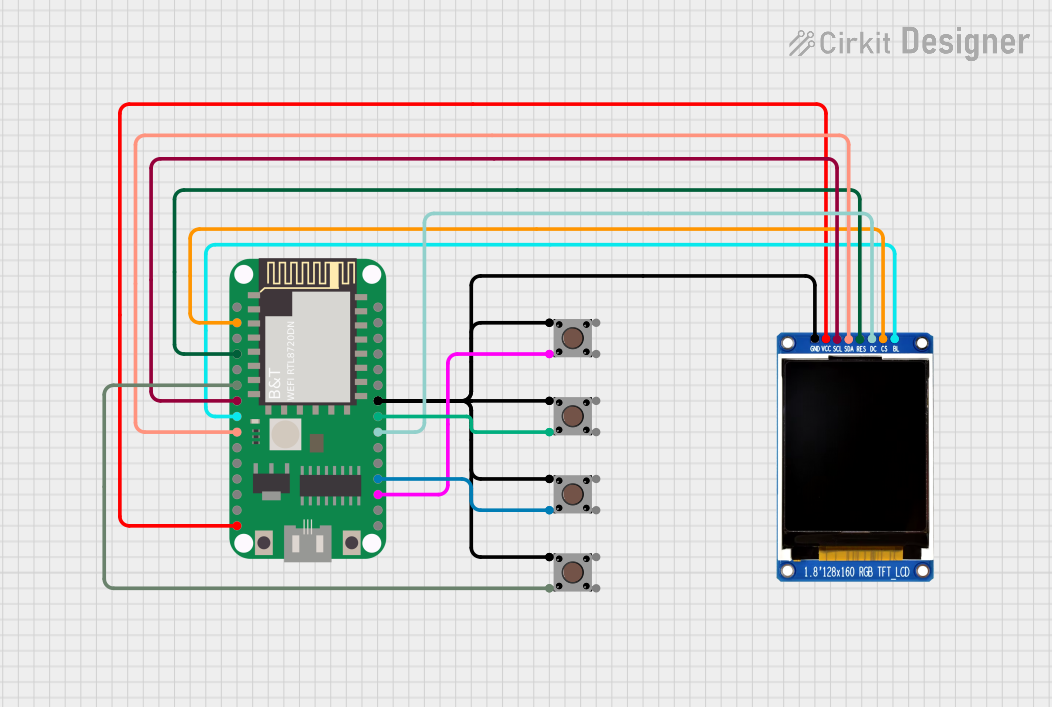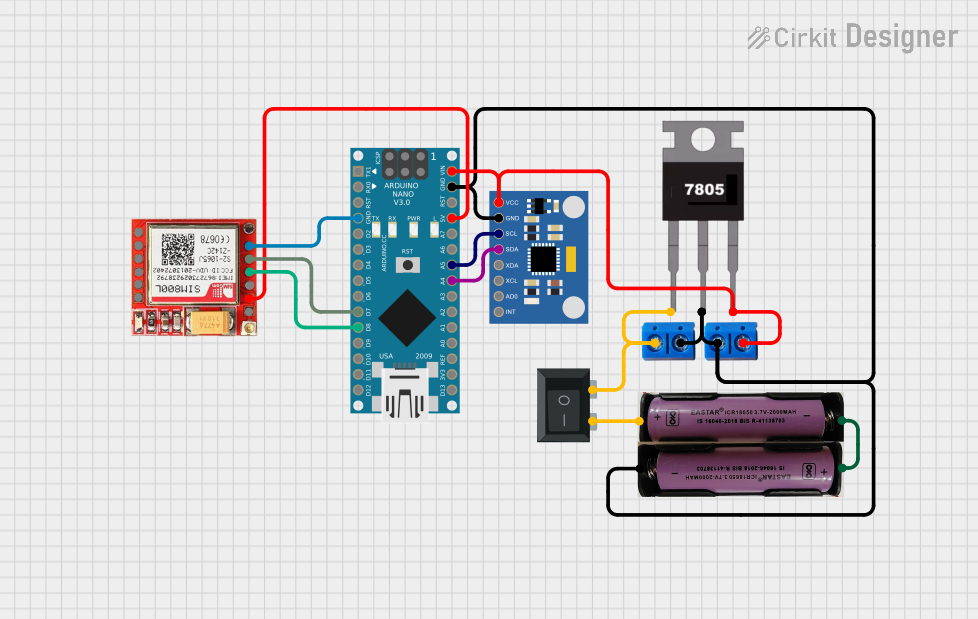
How to Use SK6805-1515: Examples, Pinouts, and Specs

 Design with SK6805-1515 in Cirkit Designer
Design with SK6805-1515 in Cirkit DesignerIntroduction
The SK6805-1515 is a compact and efficient voltage regulator designed to provide a stable output voltage of 1.5V with a maximum output current of 1A. This component is ideal for low-power applications, ensuring consistent voltage levels for microcontrollers, sensors, and other electronic devices. Its small form factor and reliable performance make it a popular choice in embedded systems, portable devices, and battery-powered circuits.
Explore Projects Built with SK6805-1515

 Open Project in Cirkit Designer
Open Project in Cirkit Designer
 Open Project in Cirkit Designer
Open Project in Cirkit Designer
 Open Project in Cirkit Designer
Open Project in Cirkit Designer
 Open Project in Cirkit Designer
Open Project in Cirkit DesignerExplore Projects Built with SK6805-1515

 Open Project in Cirkit Designer
Open Project in Cirkit Designer
 Open Project in Cirkit Designer
Open Project in Cirkit Designer
 Open Project in Cirkit Designer
Open Project in Cirkit Designer
 Open Project in Cirkit Designer
Open Project in Cirkit DesignerCommon Applications
- Powering microcontrollers and digital ICs
- Voltage regulation in battery-operated devices
- Low-power embedded systems
- Portable electronics requiring a stable 1.5V supply
Technical Specifications
The following table outlines the key technical details of the SK6805-1515:
| Parameter | Value |
|---|---|
| Output Voltage | 1.5V |
| Maximum Output Current | 1A |
| Input Voltage Range | 2.5V to 6V |
| Dropout Voltage | 200mV (typical at 1A load) |
| Quiescent Current | 50µA (typical) |
| Operating Temperature | -40°C to +85°C |
| Package Type | SMD (Surface-Mount Device) |
Pin Configuration
The SK6805-1515 is typically available in a 3-pin SMD package. The pinout and descriptions are as follows:
| Pin Number | Pin Name | Description |
|---|---|---|
| 1 | VIN | Input voltage (2.5V to 6V) |
| 2 | GND | Ground (0V reference) |
| 3 | VOUT | Regulated output voltage (1.5V) |
Usage Instructions
How to Use the SK6805-1515 in a Circuit
- Input Voltage: Connect the input voltage (VIN) to a DC power source within the range of 2.5V to 6V. Ensure the input voltage is at least 200mV higher than the desired output voltage (1.5V) to maintain proper regulation.
- Output Voltage: Connect the load to the VOUT pin. The output voltage will be regulated to 1.5V.
- Ground Connection: Connect the GND pin to the ground of the circuit.
- Decoupling Capacitors: Place a 10µF capacitor close to the VIN pin and a 10µF capacitor close to the VOUT pin to ensure stability and reduce noise.
Important Considerations
- Thermal Management: Ensure adequate heat dissipation, especially when operating near the maximum current of 1A. Use a PCB with good thermal conductivity or add a heatsink if necessary.
- Input Voltage Ripple: Minimize input voltage ripple by using a low-ESR capacitor at the input.
- Load Current: Do not exceed the maximum output current of 1A to avoid damaging the regulator.
Example: Using the SK6805-1515 with an Arduino UNO
The SK6805-1515 can be used to power an Arduino UNO or other microcontrollers that require a stable 1.5V supply for specific components. Below is an example circuit and code to demonstrate its usage:
Circuit Setup
- Connect the VIN pin of the SK6805-1515 to a 5V power source.
- Connect the GND pin to the ground of the circuit.
- Connect the VOUT pin to the 1.5V input of the desired component (e.g., a sensor or peripheral).
Arduino Code Example
// Example code to read data from a sensor powered by the SK6805-1515
// The sensor operates at 1.5V and is connected to the Arduino's analog pin A0.
const int sensorPin = A0; // Analog pin connected to the sensor output
int sensorValue = 0; // Variable to store the sensor reading
void setup() {
Serial.begin(9600); // Initialize serial communication at 9600 baud
}
void loop() {
sensorValue = analogRead(sensorPin); // Read the sensor value
Serial.print("Sensor Value: ");
Serial.println(sensorValue); // Print the sensor value to the Serial Monitor
delay(1000); // Wait for 1 second before the next reading
}
Troubleshooting and FAQs
Common Issues and Solutions
No Output Voltage:
- Cause: Input voltage is below the minimum required (2.5V).
- Solution: Ensure the input voltage is within the specified range (2.5V to 6V).
Output Voltage is Unstable:
- Cause: Insufficient decoupling capacitors or high input ripple.
- Solution: Add low-ESR capacitors (10µF) close to the VIN and VOUT pins.
Overheating:
- Cause: Excessive load current or poor thermal dissipation.
- Solution: Reduce the load current or improve heat dissipation using a heatsink or thermal vias.
Output Voltage is Incorrect:
- Cause: Faulty connections or damaged component.
- Solution: Verify all connections and replace the SK6805-1515 if necessary.
FAQs
Q1: Can the SK6805-1515 be used with a 3.3V input?
A1: Yes, the SK6805-1515 can regulate a 3.3V input to 1.5V, as long as the input voltage is at least 200mV higher than the output voltage.
Q2: What is the maximum load current the SK6805-1515 can handle?
A2: The maximum load current is 1A. Exceeding this limit may damage the regulator.
Q3: Is the SK6805-1515 suitable for battery-powered applications?
A3: Yes, its low quiescent current (50µA typical) makes it ideal for battery-powered devices.
Q4: Can I use the SK6805-1515 without input and output capacitors?
A4: No, input and output capacitors are essential for stable operation and noise reduction. Use 10µF capacitors as recommended.